Special blue-blocking glasses, lamps that emit no blue and little green light, and apps that shift the color temperature of our smartphones and iPads have been designed to remove potentially sleep-disrupting light.
But how do these blue blocking glasses and lamps help with sleep?
And how do they need to be designed and used to actually work?
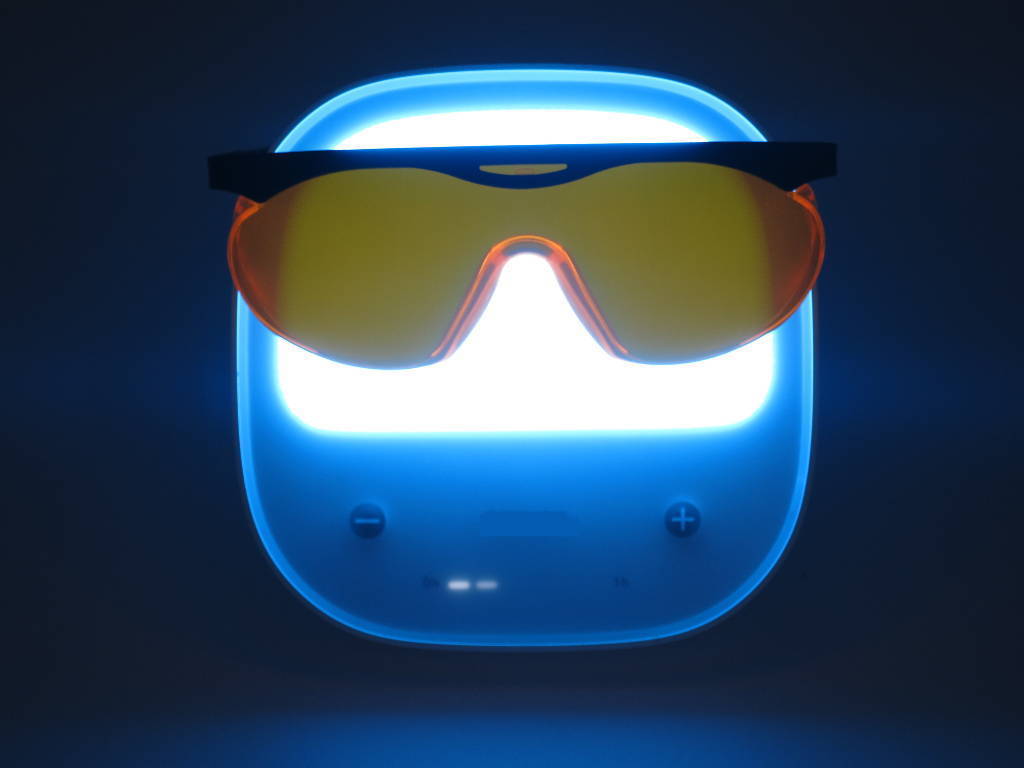
A couple of years ago, I was often riding the subway home late in the evening, coming either from work or a night on the town. For the first couple of minutes, I usually felt very sleepy and was ready to go to bed. At the end of my ride though, I was completely alert. At some point, I started wondering whether the bright light in the subway car might be responsible for my alertness at the end of the ride.
I had previously heard of morning bright light therapy to wake people up and treat bad winter moods, and the subway car seemed to be doing just that.
The problem: we were in the middle of the night!
Looking further into the alerting effects, I came across a whole line of research that had identified the blue light portion of white light as the most potent wake-up signal.
In 2001, researchers identified novel photosensitive cells at the back of our eyes, and these cells were most responsive to blue light. What’s more, they are directly connected to our biological clock. It has been found that light exposure to these cells resets our internal clock, suppresses melatonin, and keeps the clock in sync with our 24-hour day.
Likely unaware of these findings, from 2005 on governments were starting to pressure manufacturers and households to get rid of incandescent light bulbs and replace them with more energy-efficient compact fluorescent lamps and later white LEDs.
As it turns out, most of these lamps contain a lot more blue light than the old bulbs, and they have also been found to be a lot more effective at suppressing melatonin, the primary hormone that signals darkness to the cells in our body. The same goes for modern LED-powered devices including smartphones, tablets, and PCs.
Let’s look at how light impacts our biological clock
Each and every one of us has an internal biological clock that controls our sleep-and-wake rhythm and serves as the master clock for all our bodily functions. This master clock is called the suprachiasmatic nucleus (SCN). It is a tiny, neuron-dense brain region located in the hypothalamus.
There are many peripheral body clocks throughout our body, but it is the SCN that keeps them all in sync.
It turns out that most people’s clock runs a day that is slightly longer than 24 hours, on average about 24 hours and 11 minutes to be more precise.1
Light is the strongest circadian pace maker. It helps us to wake up in the morning and resets our biological clock.
Every morning, sunlight readjusts the clock by a couple of minutes and hence allows us to keep in sync with our 24-hour day.
The retina at the back of our eyes contains a special type of photo receptor that allows our biological clock (the SCN) to detect and respond to light
The retina contains the well-known rods and cones that allow us to see, but there is also a third type that has everything to do with the clock:
In the early 2000s, scientists discovered a new type of photosensitive cells, called intrinsically photo sensitive retinal ganglion cells (ipRGC), which are directly connected to the SCN. It is mainly these ipRGC that signal light to the SCN and entrain it to a 24-hour day.
The ipRGC contain the photopigment melanopsin, which is most sensitive to light in the range of 450 to 480 nanometers (nm).2
As you can see in the table below, the maximum sensitivity of these photo receptors is right in the blue light range.
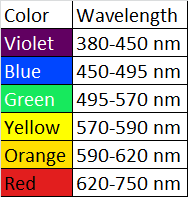
Now take a look at the light spectrum of the sun in Los Angeles at 10 am on a sunny morning. There is a lot of blue in the morning sun. This is the kind of light that wakes us up and resets (entrains) our clock every morning:
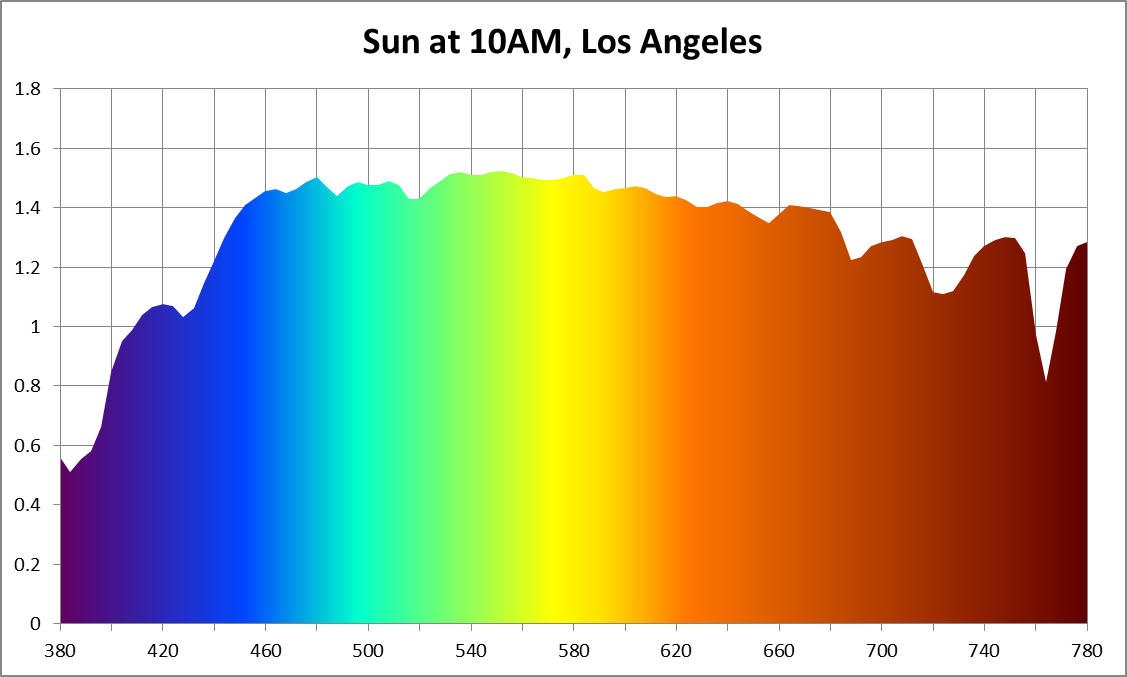
Unless we change the time zone, however, we only need to adjust our clock by a few minutes every day.
Light at the wrong time confuses our circadian clock and disrupts our sleep
If light resets the clock, then light at the wrong time should set our clock to the wrong time. And that is exactly what happens.
Unfortunately, our SCN doesn’t have a display where we can precisely read our subjective time and understand how far it is off compared to our 24-hour day. So researchers had to look for indicators to help us understand where we are in our own circadian rhythm (circadian=circa (about) + dian (day)).
Temperature and melatonin secretion aren’t constant, but vary, following this internal rhythm. Both melatonin onset and body temperature minimum are reliable markers for our subjective time.
Melatonin is secreted by the pineal gland in response to signaling from the SCN (via the sympathetic nervous system) for about 10 hours during our biological night, regardless of whether we are asleep or not. Even in total darkness, melatonin is not secreted for 24 hours non-stop. It rises, plateaus for a while near its maximum, and then declines again. However, there is an overriding mechanism: Light suppresses melatonin and shortens its duration by delaying its onset.3
In normal sleepers, core body temperature reaches its minimum about 3 hours before wake-up. There are, however, huge variations from person to person.4
Body temperature variation over 24 hours in one individual:
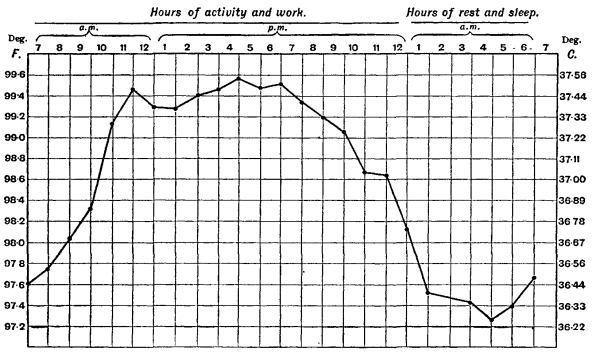
What happens to our biological clock time when we expose ourselves to light during the night?
Light exposure at night before the temperature minimum sets the biological clock to a later time (delays it), while exposure after the minimum sets it to an earlier time (advances it).
This way, delays of up to 3 hours and advances of up to 2 hours in a single night are possible.5
The problem is that while our SCN can reset relatively fast, peripheral body clocks in organs might take several days to catch up with the SCN. The liver, for example, can take 16 days or more to respond to a delay of the clock by 6 hours (e.g., moving from New York to Honolulu).6
If we constantly shift our clock by exposing the SCN to light at different hours during the night, we may experience constant jet lag.
An hour of office light exposure (500 Lux) in the evening, for example, can suppress melatonin secretion by 50% and change the clock by 30 minutes. Even dim light of 100 lux can interfer with melatonin production and delay sleep.7
Blue light has the strongest influence on our clock
Multiple experiments have shown that exposure to light in the evening suppresses melatonin, and that the most powerful suppressant is blue light.
It suppresses melatonin twice as much and delays our clock twice as much as green light.8 In addition, blue light in the evening promotes alertness.
Because of its powerful melatonin- and clock-shifting characteristics, blue and blue-green light are used in light therapy devices and glasses at a much lower intensity than white light.
Modern lighting, smartphones, iPads, and PCs with LED screens emphasize the blue light portion of the visible spectrum.
Old-fashioned incandescent light bulbs had a light spectrum resembling the evening sun with a low amount of blue light.

On the other hand, modern white LED lighting and devices with LED screens feature a peak in the blue-light range of the visible spectrum. This kind of light is different from anything we have used in the history of human kind.


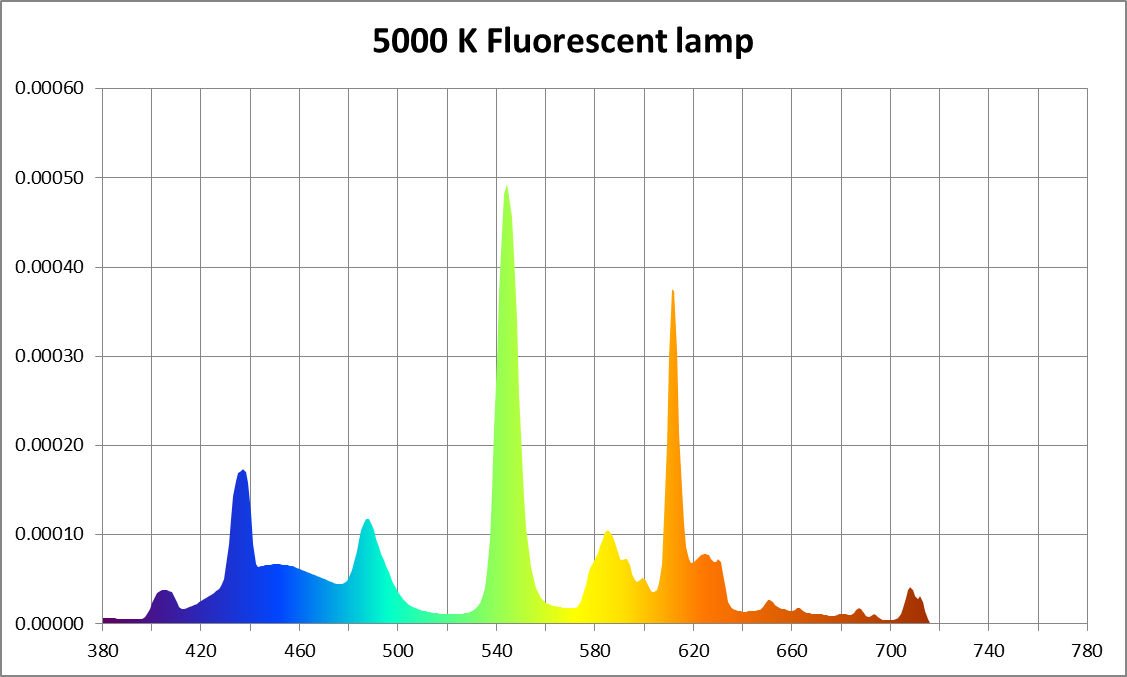
Evening use of modern smartphones, tablets, and PCs messes with our sleep
You may wonder whether smartphone and tablet LED screens are powerful enough to disrupt our sleep, and in fact, some have argued that they don’t make a difference. However, recent science has clearly found they do:
In 2015, Dr. Chang and colleagues tested whether evening-reading via an LED-powered device disrupts sleep more than reading a traditional paper book using reflected background light (coming from a 4100K CFL). LED e-readers suppressed melatonin and shifted the circadian clock significantly more. What’s more, participants using them needed 10 minutes longer to fall asleep and had less REM sleep.9
Would a Kindle or other e-Ink reader be safer?
E-ink is based on light reflection not emission, so I would say yes, a Kindle should be comparable to a paper book. But you might want to switch off the background light and use an amber reading light instead.
This does not apply to the Kindle Fire, which is a normal tablet with an LED screen.
If blue light suppresses melatonin, then how big of an impact does blocking blue light have on melatonin?
Does removing the blue light spectrum from a light source help to preserve melatonin levels at night?
In 2013, researchers at the University of Groningen melted a yellow filter on a standard warm-white fluorescent tube. The filter removed short-wave light below 530 nm (blue light and blue-green light) from the emitted light. Subjects were exposed for a full night (11 pm to 7 pm) to either dim light (<5 lux), the unaltered lamp (256 lux), or the lamp with the yellow filter (193 lux). Melatonin was reduced by 45% on average in participants who were exposed to the unaltered lamp compared to dim light, while the reduction was only 6% in participants exposed to the modified lamp.10
So using a lamp that doesn’t emit blue light, such as an amber reading light, can be very effective.
However, blocking blue light at the source is often beyond us.
City officials might take offense if you are trying to attach yellow filters to subway lighting or knock out the LED lamps on a brightly lit street at night.
Blue-light blocking glasses can be just as effective and put you back in the driver seat.
In recent years, quite a few experiments have been done to assess the efficacy of blue-blocking glasses at avoiding melatonin suppression.
In a simulated night-shift experiment, subjects were exposed to three different experimental conditions on three non-consecutive nights. During the first night, their melatonin secretion was assessed under dim light. On two further nights, they were placed in a well-lit room (800 lux) to simulate the conditions in a night-shift work setting. During one night, participants wore light-filtering goggles that selectively blocked all light below 530 nm, while during another night they were exposed to the same light without wearing goggles.
Melatonin onset and levels in the dim light and the goggle conditions were almost the same, while melatonin in the no-goggle condition was dramatically suppressed and its onset delayed by several hours.11
But does wearing blue light blocking glasses at night really improve sleep?
Two experiments and a self-experiment directly investigated this question.
In 2009, Burkhart and Phelps investigated whether wearing blue-light blocking glasses 3 hours before sleep would help insomniacs (18-68 years) who had difficulty falling asleep (sleep onset insomnia) or maintaining sleep to improve their sleep. They compared amber glasses that completely blocked wavelengths <525 nm and around 50% at 550 nm (blue and blue green) with clear glasses that only blocked UV light. Participants completed sleep diaries for one week before wearing the glasses and for two weeks while they were wearing the glasses. The group wearing the blue-blockers experienced significantly improved sleep and mood.12
In 2017, Ari Schechter and colleagues had insomniacs wear either amber-colored glasses (Uvex Bandit style, amber) that filter about 65% of blue light or clear glasses for two hours before bedtime (one week). Note that the glasses used here blocked a lot less blue light than the ones used in previous experiments.
The study had a crossover design, that is, all study participants had to undergo both conditions. In a questionnaire preceding the experiment, participants reported unrefreshing sleep, difficulty staying asleep, difficulty falling asleep, and frequent awakenings. While glasses were off during sleep, the participants were instructed to put them on before using any light (for example to go to the bathroom) or electronic device at night. Total sleep time and sleep quality were significantly improved when participants wore amber glasses.13
What is striking to me is that the amber glasses used in this trial blocked a lot less of the blue light spectrum than the ones used in the previously mentioned studies, yet they were still effective.
I suspect that blue-blockers that also filter more of the blue-green light (e.g., Uvex with the SCT-Orange filter instead of the amber filter) would have shown even more impressive results.
On the other hand, the glasses used in this study also let more visible light through (around 90%), which may be more acceptable to some users.
Quantified Self Movement
At the 2013 Quantified Self meetup in Boston, Sanjiv Shah reported on an exciting self-experiment. He compared wearing yellow-tinted glasses every evening for 3 hours before his usual bed time at 12 am for 14 days with not wearing the glasses for 14 days.
During the first 14 days, when he was not wearing the glasses, it took him on average 30 minutes to fall asleep and he had about 60 minutes of deep sleep.
During the following 14 days, he was wearing the glasses: it took him only about 4 minutes to fall asleep and he improved his deep sleep to 90 minutes.
These are staggering improvements, and at least for him, the improvements came really fast.
He used Uvex glasses with SCT-Orange filter, which almost completely block blue and blue-green light up to 540 nm and around 50% at 550 nm.
Here is his very interesting talk from the QS meetup in Boston:
Shanjiv also varied the time he was wearing the glasses from 1 to 5 hours before bed. For him, 3 hours was the most effective dose.
So avoiding blue light in the evening either through glasses that filter it or light sources that don’t emit it can go a long way to help with sleep.
I want to conclude this experiment section with the very interesting red-visor cap study
In 2011, Higuchi conducted another night-shift experiment. They exposed participants to 500 lux overhead light from 11 pm to 3 am. In the experimental condition, participants wore a cap with a red, semi-transparent visor. Wearing the visor-cap led to largely preserved melatonin levels. There was a suppression of approximately 7 % compared to nearly 53 % in the no-visor condition.14
How can this be explained? Well, first of all, less light reaches the eyes if you are wearing a cap with a visor.
More interestingly, in 2003, Glickman convincingly showed that the density of the ipRGC (the blue-light photoreceptors that are connected to our clock) is much higher in the lower part of the retina.15
If you are upright, light shining at an angle from above (like the sun) is therefore much more effective at exciting the ipRGC and suppressing melatonin than light being reflected from the floor.
So, a cap with a visor can be quite effective at preventing melatonin suppression at night, provided the light is coming from above. It won’t help against the disturbance caused by looking at an iPad at night though.
Practical ways of blocking blue light at night
- Don’t emit it, e.g., by only using amber or red light sources at night.
- Use an app like f.lux (PC) or nightshift (iPad, iPhone) that automatically adjusts the color spectrum of your electronic device according to the time of the day.
- Filter out blue light at night with special blue blocking glasses.
Street lighting, office light, subway illumination, and often even the lighting in our home are beyond our control, but we need to block blue light from all these sources to test whether this helps us sleep better.
Blue light blocking glasses are a practical tool to start with.
What kind of blue blocking glasses help most with sleep?
Looking on the Internet, you will find amber sleep glasses, yellow glasses, and glasses that seem almost not to be tinted at all. All of them claim to be blocking blue light.
So what is the difference?
There are a lot of blue blockers out there that are designed to reduce eye strain while you are working on your computer. Those may be great glasses, but for a different purpose. A lot of them leave too much blue-green light that can suppress melatonin and disturb sleep.
To replicate the successful experiments described above, you want to look for glasses that block most of the blue light and blue-green light up to about 540 nm.
Good glasses should come with a curve that shows what is actually being filtered, so you can see what you are getting.
Among others, the following companies supply glasses with clear specifications and similar characteristics as the one’s used in the blue-light experiments:
Uvex glasses with SCT-Orange filter:
These are usually the cheapest option. They have been used with great success in the self-experiment described above. I use them too.
- Uvex Skyper with SCT-Orange filter
- Uvex Ultra-spec 2000 (better option if you need blue light blocking glasses that fit over prescription glasses).
The Uvex glasses look geeky though!
LowBlueLights glasses:
I contacted LowBlueLights (successfully used in experiments above) and found them very responsive and helpful. LowBlueLights also carry blue light blocking glasses that can be worn over prescription glasses and a variety of lamps that don’t emit blue light.
Co-founder and chief scientist, physicist Dr. Richard Hansler has more than 40 years experience in the lighting industry. He has written some very interesting books on the topic, including Great Sleep! Reduced Cancer! (second edition).
Somnilight:
Somnilight amber sleep glasses also feature suitable filtration characteristics. They also have glasses that go over prescription glasses, as well as amber night lights that emit almost no blue or green light.
Beware of light seeping in at an angle from the top or the sides
As mentioned above, the lower half of the retina contains most of the clock-setting photo receptors, so you want to avoid light coming from above or at an angle from above. You ideally want to look for glasses that completely shield you from this light.
As an alternative, you could additionally were a cap with a visor as demonstrated in the Japanese experiment by Higuchi described above.
How to use blue light blocking glasses for sleep?
In the two experiments that have directly investigated blue light blockers and sleep, the participants were directed to wear the glasses 2 and 3 hours before their usual bedtime respectively. Note that participants’ main complaints were difficulty falling asleep and staying asleep.
In his self-experiment, Sanjiv Shah tried wearing them for 1 up to 5 hours before bed. He found 3 hours worked best for him, but everyone is different, so you might want to try different durations as well. His main complaint before using the glasses was that he would lie in bed for a long time before being able to fall asleep.
If your problem is that it takes you too long to fall asleep at night, I would suggest to start with 2 hours before bed time.
However, if you find yourself falling asleep too early in the evening (and awakening too early in the morning), wearing them in the evening is probably not a good idea. In this case, avoiding the early morning light and wearing them for two hours in the morning might help.
This could also be combined with exposing yourself to bright light late in the evening to delay (push back) your internal clock.
Do not use blue-blocking glasses with the specifications described here while driving a car or operating any kind of machine, as you will not see some colors and see other colors differently. If in doubt, contact the manufacturer.
This brings us to the end of this post.
Our ancestors didn’t have to worry much about light pollution and artificial light disrupting their sleep. For most of our history, we had no other light sources than the sun, the stars, the moon, and fire. What’s more, “more recent” traditional light sources like candles and kerosene lamps emit almost no blue light.
We lived perfectly in sync with the natural night-and-day cycle, and our biological clock only had to adapt to the gradually changing day-length brought about by the seasons.
I wish you a most restful sleep.
Notes:
- See Blue Light and Sleep Notes for references.
- A great introduction into our biological clock can be found at How does the biological clock work? on Psycheducation.org, a very informative website on mood and bipolar disorders by Dr. James Phelps, M.D.
- In his lecture Biology in Four Dimensions, Dr. Joseph Takahashi, Ph.D. beautifully describes the relationship between our central biological clock (the SCN) and the various peripheral body clocks.
- The spectral data used in the charts is licensed from the f.luxometer project (https://fluxometer.com/) and f.lux Software LLC by CC-Attribution: https://creativecommons.org/licenses/by/4.0/
- Image credits:chart showing diurnal variation in body temperature, public domain.
 10 simple actions that can double your productivity
10 simple actions that can double your productivity
FREE guide of my top productivity hacks for subscribers to my free newsletter
